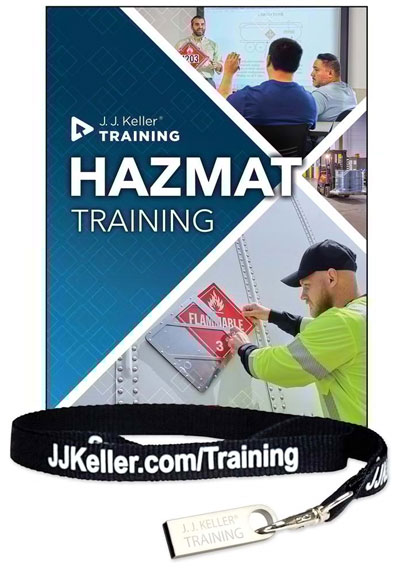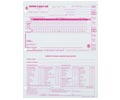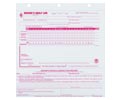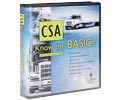Hazmat Training Program - USB and Digital Download

50089
Looking to improve safety and compliance when shipping hazardous materials? Our Hazmat Training Program - available on USB and digital download - is here to help!
Hazmat materials such as gasoline, oxygen, propane, and fireworks can pose a significant risk to health, safety, and property when shipped. That's why the Department of Transportation (DOT) has put in place regulations around the handling and transportation of hazardous materials.
Our training program is designed to help hazmat workers understand and follow these regulations, ensuring that all materials are safely packed and handled during shipping. Our program covers everything from general awareness and safety training to security awareness and function-specific training, as required by the Hazardous Materials Regulations (HMR) set forth by The Pipeline and Hazardous Materials Safety Administration (PHMSA).
- Compliance with DOT and PHMSA regulations
- Increased safety for employees and property
- Convenience with USB and digital download options
- Effective training in all required areas
- Customizable to suit specific needs
- Reduced risk of fines and legal issues
- Peace of mind for employers and employees
Hazmat Training Program
With our Hazmat Training Program, you can rest assured that your employees will receive the necessary training, testing, and certification required by the HMRs.
This includes initial training within 90 days of employment or a job function change, as well as refresher training every three years.
Don't take chances when it comes to hazmat shipping compliance. Invest in our Hazmat Training Program today and ensure that your employees are equipped with the knowledge and skills they need to handle hazardous materials safely and effectively.
Please note: 49 CFR 172.704(d) of the HMR requires each hazmat employer to create and retain a record certifying the current training of each hazmat employee.
It is the responsibility of the hazmat employer to complete additional company-specific training in order to formally certify each learner.
Trainers may use the J. J. Keller-issued certificate for compliance with the recordkeeping requirements in Section 172.704(d)(3). The trainer and the trainer’s company are considered the “person providing the training” in Section 172.704(d)(4).
Because of this, trainers should maintain additional records documenting a description or copy of the additional company-specific training materials provided to each learner.
- Regulations Covered: 49 CFR Parts 107-180 and 49 CFR Part 397
- Intended Audience: All hazmat employees, in all industries, who are responsible for any aspect of shipping or transporting hazardous materials
- Languages: English and Spanish
Formats
| Same Great Content Available in 3 Options | Option 1: USB Only | Option 2: Digital Download Only | Option 3: USB + Digital Download |
| Main Video Program* | |||
| General Awareness (9 mins) | Yes | Yes | Yes |
| Safety (9 mins) | Yes | Yes | Yes |
| Security Awareness (11 mins) | Yes | Yes | Yes |
| Highway Transportation (18 mins) | Yes | Yes | Yes |
| Labeling (13 mins) | Yes | Yes | Yes |
| Lithium Batteries (22 mins) | Yes | Yes | Yes |
| Loading, Unloading, and Load Segregation (15 mins) | Yes | Yes | Yes |
| Marking (20 mins) | Yes | Yes | Yes |
| Packaging (13 mins) | Yes | Yes | Yes |
| Placarding (18 mins) | Yes | Yes | Yes |
| Reporting an Incident (10 mins) | Yes | Yes | Yes |
| Shipping Papers (15 mins) | Yes | Yes | Yes |
| The Hazardous Material Table (17 mins) | Yes | Yes | Yes |
| Trainer Tools* | Yes | Yes | |
| (13) Trainer Guide PDFs | Yes | Yes | Yes |
| (13) Customizable PowerPoint Presentations | Yes | Yes | Yes |
| (13) Quizzes | Yes | Yes | Yes |
| (13) Answers | Yes | Yes | Yes |
| (13) Certificate of Completions | Yes | Yes | Yes |
| Various Handouts, Exercises, and more | Yes | Yes | Yes |
| Employee Packet | |||
| (1) Employee Workbook | Yes | Yes | |
| (1) Hazardous Materials Warning Label Chart | Yes | Yes | |
| (1) Hazardous Materials Placard Chart | Yes | Yes | |
| (1) Hazmat Marking Chart | Yes | Yes | |
| (1) Hazmat Load & Segregation Chart | Yes | Yes | |
| *Available in English and Spanish |
What's Covered
After viewing the 13 videos below, learners will have a better understanding of these important Hazmat topics:
- General Awareness:
- Describe what information on the hazmat table is needed to determine if a material is hazardous
- Recognize the hazard classes and divisions on the hazmat table
- Recognize examples of a hazardous substance, hazardous waste, marine pollutant, elevated-temperature material, and limited quantity material
- Identify the purpose of shipping papers, markings, labels, and placards
- Hazmat Training: Safety:
- Identify the emergency response information that needs to be provided for a hazmat shipment
- Describe where the emergency response phone number needs to be located and how it needs to be monitored
- Describe where the carrier’s contact information needs to be located and who needs to use it
- Security Awareness:
- Recognize the importance of hazmat security and potential security threats
- Identify ways to reduce the risk of security threats
- Identify suspicious behaviors
- Describe how to report suspicious activity
- Highway Transportation:
- Explain what additional licensing and registration requirements are necessary before transporting hazmat
- Decide what hazmat documentation is needed and where to store it during transport
- Take precautions to keep your cargo safe and secure during transport
- Discuss what you, the driver, will do in the event of a hazmat incident or accident
- Labeling:
- Explain labeling specifications and requirements
- Identify hazmat labeling and describe what each label means
- Lithium Batteries:
- Determine proper shipping requirements for lithium batteries
- Identify appropriate packaging for transport
- Recognize which marking and labels are required
- Explain when shipping papers must be completed
- Loading, Unloading, and Load Segregation:
- Apply loading and unloading requirements for safe hazmat handling
- Navigate the segregation and compatibility tables to determine proper strategies for the storage and transportation of hazardous materials
- Marking:
- Explain marking specifications and requirements for both non-bulk and bulk packaging
- Identify hazmat markings and describe what each marking means
- Packaging:
- Identify the manufacturer’s markings on a hazmat packaging and describe what each code means
- Explain how to select appropriate hazmat packaging
- Placarding:
- Explain placarding specifications and requirements
- Identify hazmat placarding and describe what each placard means
- Reporting an Incident:
- Explain when and how to report a hazmat incident via telephone
- Identify when and how to submit a written incident report to PHMSA
- Shipping Papers:
- Explain the importance of shipping papers and how to fill them out
- Identify shipping paper retention requirements
- The Hazardous Materials Table:
- Explain what the hazmat table is and why it is important in the hazmat transportation process
- Navigate the hazmat table to verify information regarding hazardous materials
Basic System Requirements
- A 400 Mhz or faster Intel-compatible CPU
- A video card with AGP architecture and at least 4 MB of onboard RAM
- At least 128 MB of system RAM (Windows 2000, XP and Vista users - 256 MB or more is recommended)
- Windows 98 SE, Windows 2000, Windows Millennium Edition, Windows XP or Windows Vista (most software DVD decoders have either reduced function or no support under Windows 95 and Windows NT 4.0)
- The latest version of Microsoft DirectX
- DVD-ROM drive (DVD discs cannot be read by CD-ROM equipment)
















